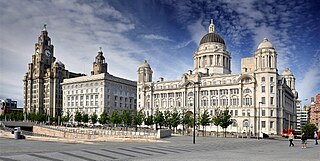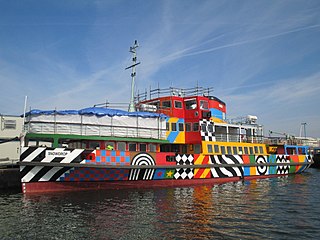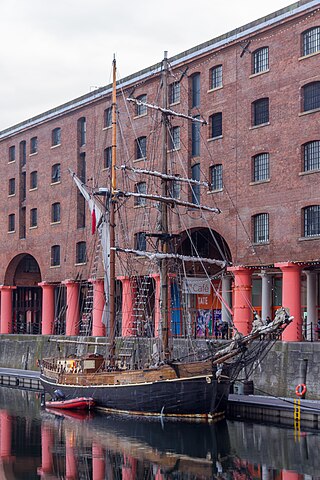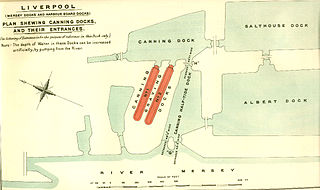
Merseyside is a ceremonial and metropolitan county in North West England. It borders Lancashire to the north, Greater Manchester to the east, Cheshire to the south, the Welsh county of Flintshire across the Dee Estuary to the southwest, and the Irish Sea to the west. The largest settlement is the city of Liverpool.

The Mersey Ferry is a ferry service operating on the River Mersey in north west England, between Liverpool to the east and Birkenhead and Wallasey on the Wirral Peninsula to the west. Ferries have been used on this route since at least the 12th century, and continue to be popular for both local people and visitors.

Bootle is a town in the Metropolitan Borough of Sefton, Merseyside, England, which had a population of 51,394 in 2011; the wider Parliamentary constituency had a population of 98,449.
Cammell Laird is a British shipbuilding company. It was formed from the merger of Laird Brothers of Birkenhead and Johnson Cammell & Co of Sheffield at the turn of the twentieth century. The company also built railway rolling stock until 1929, when that side of the business was separated and became part of the Metropolitan-Cammell Carriage & Wagon Company.

The Merseyside Maritime Museum is a museum based in the city of Liverpool, Merseyside, England. It is part of National Museums Liverpool and an Anchor Point of ERIH, The European Route of Industrial Heritage. It opened for a trial season in 1980 before fully opening in 1984 and expanding in 1986. The museum occupies warehouse block D at the Albert Dock, along with the Piermaster's House, Canning Half Tide Dock and Canning Graving Docks.

The Royal Albert Dock is a complex of dock buildings and warehouses in Liverpool, England. Designed by Jesse Hartley and Philip Hardwick, it was opened in 1846, and was the first structure in Britain to be built from cast iron, brick and stone, with no structural wood. As a result, it was the first non-combustible warehouse system in the world. It was known simply as the Albert Dock until 2018, when it was granted a royal charter and had the honorific "Royal" added to its name.

Gladstone Dock is a dock on the River Mersey, England, and part of the Port of Liverpool. It is situated in the northern dock system in Bootle. The dock is connected to Seaforth Dock to the north and what remains of Hornby Dock to the south. Part of Liverpool Freeport, Gladstone Dock is operated by the Mersey Docks and Harbour Company.

Prince's Dock is a dock on the River Mersey, England, and part of the Port of Liverpool. It is the most southerly of the docks situated in the northern part of the Liverpool dock system, connected to Prince's Half-Tide Dock to the north. The dock is now in the buffer zone to one of Liverpool's World Heritage Sites.

The Port of Liverpool is the enclosed 7.5-mile (12.1 km) dock system that runs from Brunswick Dock in Liverpool to Seaforth Dock, Seaforth, on the east side of the River Mersey and the Birkenhead Docks between Birkenhead and Wallasey on the west side of the river. The port was extended in 2016 by the building of an in-river container terminal at Seaforth Dock, named Liverpool2. The terminal can berth two 14,000 container Post-Panamax ships.

Canning Dock on the River Mersey is part of the Port of Liverpool in Northern England. The dock is in the southern dock system, connected to Salthouse Dock to the south and with access to the river via the Canning Half Tide Dock to the west. The Canning Graving Docks are accessed from the dock.
The George's Basin was a dock on the River Mersey, England, within the Port of Liverpool. The basin surface covered 3 acres (1.2 ha) and was surrounded by George's Dock to the south, Prince's Dock to the north and the Mersey to the west.

PSLelia was a steamship built in 1864, during the American Civil War for use as a blockade runner for the Confederate States of America. She sank in Liverpool Bay in 1865 in an incident that caused 46 fatalities.

The Dazzle ships of the 14–18 NOW project are artworks created to commemorate the work of the artists and artisans who developed and designed the dazzle camouflage used in the First World War by ships as a defence against U-boat attack.

The MVSnowdrop is a Mersey Ferry in operation on the River Mersey, England. From launch until a major refit in 2003, she was named MV Woodchurch.

HMS Nile was a two-deck 90-gun second-rate ship of the line of the Royal Navy, launched on 28 June 1839 at Plymouth Dockyard. She was named to commemorate the Battle of the Nile in 1798. After service in the Baltic Sea and the North America and West Indies Station, she was converted to a training ship and renamed HMS Conway, surviving in that role until 1953.

HMS Eaglet is a Royal Navy Reserve unit based in Liverpool. She is the main occupant of the Royal Navy Regional Headquarters in Liverpool, Merseyside. The base is also the home to a number of units, including:Royal Marines Reserve Merseyside, Naval Regional Command Northern England, Liverpool URNU, HMS Biter, HMS Charger, Sea Cadet Corps, and the Liverpool Royal Navy and Royal Marines Careers Office.

The MVRoyal Iris is a twin screw, diesel-electric, Mersey Ferry. The vessel was built by William Denny & Brothers of Dumbarton and launched in December 1950, costing £256,000.

Zebu, formerly Ziba, was a historic tall ship. Built in Sweden in 1938, she was used as a trading vessel until the late 1960s, before circumnavigating the globe in the 1980s. She has been based in Liverpool since the 1980s. She sank in 2015, and was subsequently restored. She partially sank again in 2021 after running aground on Holyhead breakwater after slipping her anchor, and had masts and sails removed to reduce weight so the hull could be moved. On 21 May 2021 after suffering further damage due to a storm, she was declared a wreck.

Chester Basin was a tidal basin on the River Mersey, in Liverpool, England. The basin was situated between the Pier Head and Manchester Dock.


















